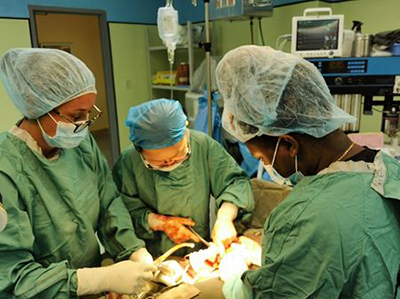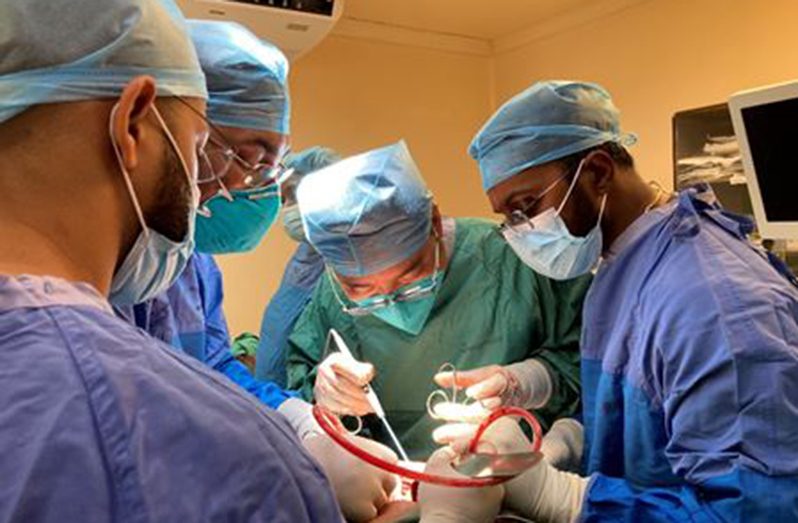THE changing seasons mark the passing of time. Since the 16th Chinese Medical Brigade arrived in Guyana, it has carried out medical aid for more than half a year. After passing the initial adaptation period, all consultants are getting better and better and have become the absolute anchors and strong dependence of their departments.
No matter in the middle of the night, in the early morning or on holidays, when receiving emergency calls, they immediately rush to the hospital to take charge of the treatment of patients. Every movement showed the courage and responsibility of the Chinese medical team. The introduction of new technologies had shown outstanding professionalism and dedication of the Chinese Medical Brigade.

“We are a team of Guardians of the Great Wall of life! We are looking forward to holding the wonderful and unforgettable experiences of Guyana, just like tasting sweet many years’ Rum, leaving us with exciting imaginations in the future,” said Dr. DAI Dechun, a point reiterated by Dr. QIAO Zhiming, Captain, the 16th Chinese Medical Brigade.
A pancreaticoduodenectomy, also known as a whipple procedure, is a major surgical operation most often performed for pancreatic head tumour, or periampullary tumour, or lower common bile duct tumour. During this procedure, surgeons remove the head of the pancreas, most of the duodenum, a portion of the bile duct, the gallbladder and associated lymph nodes. Occasionally, the surgeon may remove the body of the pancreas, the entire duodenum and a part of the stomach. This is an extensive and difficult surgery that is intended to eradicate the entire malignant cells or cancer cells. The average surgery time is six hours.
Since November 2020, Dr. Qiao Zhiming, Consultant of Hepatobiliary Surgery, had successfully completed four cases of pancreaticoduodenectomy at the Georgetown Public Hospital Corporation (GPHC). Among the four patients, three were male and one was female. The age span was 50-76 years old. Dr. Zhiming also perfectly completed the first Partington Rochelle operation for pancreatic duct stone in Guyana’s medicine history, and the patient recovered smoothly. Through the cooperation of surgery, Dr. Zhiming showed his counterparts pioneering surgery technologies and the latest ideas, which deepened mutual understanding, made Chinese doctors widely praised, and gained sincere friendships.
For every patient, Dr. Zhiming will lead the team to carry out preoperative condition assessment and detailed images analysis carefully, intraoperative prudent operation and close cooperation, postoperative rigorous ward management to ensure the safety of patients. Behind every patient’s recovery, a lot of hard work had been done by Chinese and Guyanese doctors. They would like to carry patients, one after another, to safety.
Placenta previa can result in life-threatening maternal complications such as haemorrhage and shock and in adverse infant outcomes such as prematurity, stillbirth and neonatal death. In Latin America, placenta previa occurs in about 5.1 per 1,000 pregnancies.
On April 20, during the cesarean section, Dr. Qin Gongzhao, Consultant of Obstetrics and Gynaecology, ran into the central placenta previa of the pregnant woman, and the whole placenta completely covered the cervical orifice. At the same time, part of the placenta was found implanted into the anterior muscle layer of the lower part of the uterine body during the artificial dissection.
After placental dissection, the blood sinus of the wound was opened and bleeding heavily. Dr. Gongzhao was not disorderly in the face of danger, but quick-witted in the midst of it. She skillfully used sterile surgical gloves to replace the shortage of sterilised tourniquets, strapped and compressed the lower uterine segment, so as to reduce bleeding, and quickly sutured the blood sinus.
Dr. Gongzhao made a race against time and fully demonstrated her deft surgical skills with the efforts of Dr. Pan Jianhua, Consultant of Anaesthesiology, operating room nurses, obstetricians, and Linden hospital administration office. The patient did not develop into Diffuse Intravascular Coagulation (DIC), and her uterus was finally saved.
The most effective way of controlling bleeding during childbirth is a hysterectomy. Losing a uterus could be physically and psychologically devastating for a young woman. Dr. Gongzhao said that she knew the reason very well as a woman and has the obligation to protect every woman’s uterus as an obstetrician and gynaecologist.
The battle for the uterus had been hard and lasted more than two hours. The total amount of bleeding was about 2000 ml, but the result was satisfying. This is also the first successful rescue case of dangerous placenta previa to preserve uterus in Linden Hospital Complex (LHC).



.jpg)








